Table of contents
- Tracer 900 GT, Multistrada 950, Versys 1000 Tourer and Tiger Sport 4 all-rounders with travel talents
- All-rounders, adventure tourers, crossover bikes
- Yamaha Tracer 900 GT
- Ducati Multistrada 950
- Kawasaki Versys 1000 Tourer
- Triumph Tiger Sport
- ergonomics
- Serpentine test drive
- 2018 no update for Tiger Sport
- Case, payload, connectivity
- Braking, straight-ahead wind protection
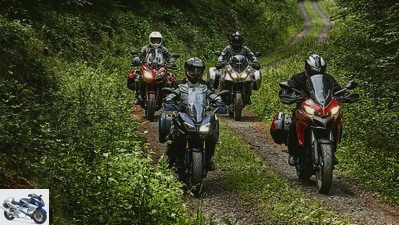
Volker Rost
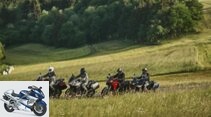
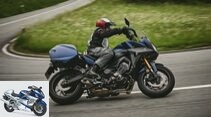

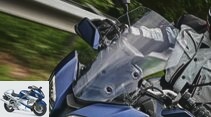
28 pictures
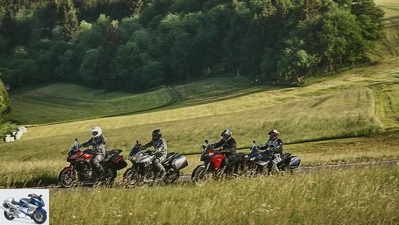
Volker Rost
1/28
The four models Yamaha Tracer 900 GT, Ducati Multistrada 950, Kawasaki Versys 1000 Tourer, Triumph Tiger Sport in a comparison test.
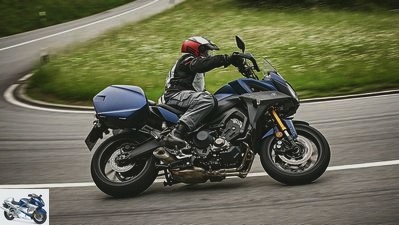
Volker Rost
2/28
Curve artist with a mere 847 cubic meters. The design? Edgy and crispy.

Volker Rost
3/28
Matt blue paint “Phantom Blue” looks great on the better equipped GT. It has heated grips, a suitcase, fully adjustable fork with golden stanchions and a strut with a rotary knob.
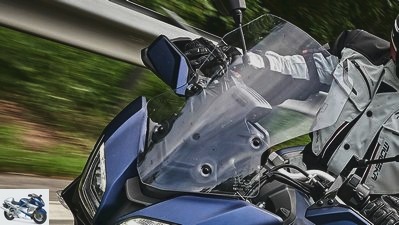
Volker Rost
4/28
There was a new, enlarged window for the 2018 model year. It only provides mediocre shielding, but can be moved five centimeters in height with one hand.
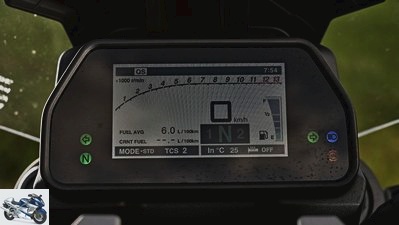
Volker Rost
5/28
YAMAHA The beautiful high-contrast TFT display with a colorful tachometer is another characteristic of the GT version. Reminds of the R1.
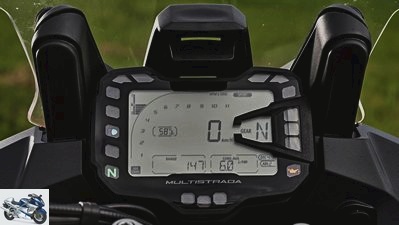
Volker Rost
6/28
DUCATI Large LCD tablet with lots of information and a prominently framed gear display. Operation from the handlebar.
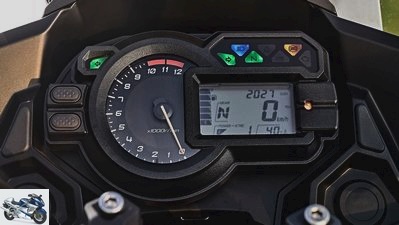
Volker Rost
7/28
KAWASAKI A dominant, clearly structured tachometer is emblazoned here in the mix with sufficiently large LCD information and control lights.
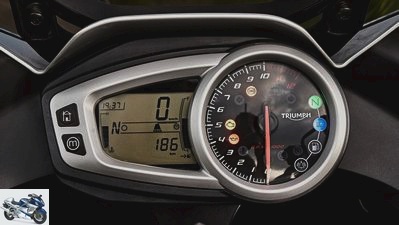
Volker Rost
8/28
TRIUMPH Delicate, a little frumpy, the liquid crystals are pixelating to themselves; somewhat thick tachometer needle.
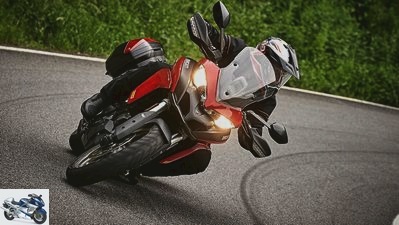
Volker Rost
9/28
Always enough power: ten years ago not even the most powerful enduro bikes had 113 hp rated power.

Volker Rost
10/28
Elegant Italian shapes. Compact: flat silencer, well-integrated case holder.
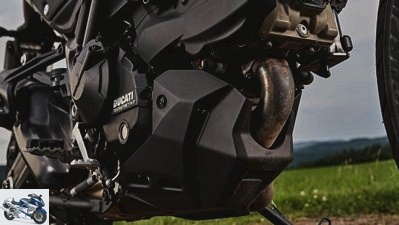
Volker Rost
11/28
Beguiling, medium-sized V2 with at least 937 cm3. Willing to turn or greedy for speed? At 100 km / h in the sixth, the Duc turns 600 rpm higher than the Tiger.
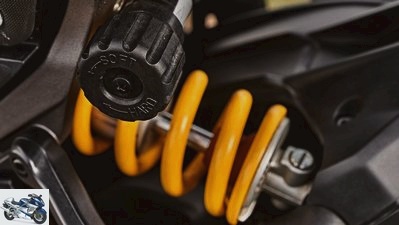
Volker Rost
12/28
Easy to grip: practical handwheel for adjusting the spring base – as with the Tracer GT. Except that the Ducati has a directly hinged shock absorber.
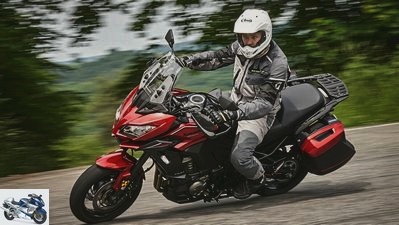
Volker Rost
13/28
“Once with everything, please!” Kawasaki’s Versys 1000 always has particularly plush seats and a generous bridge for luggage. The “Tourer” version also comes with standard cases and hand protectors.
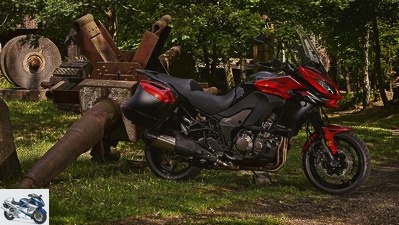
Volker Rost
14/28
Kawasaki with vertical shaft (that’s really the name of the device from the basalt extraction) – and yet not a W 650. The Versys is a veritable, well-equipped touring motorcycle with no flair.
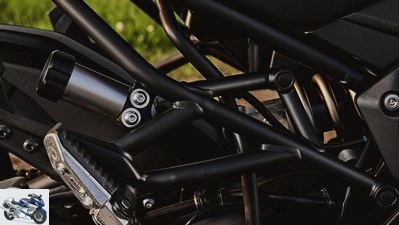
Volker Rost
15/28
Practical here too: hydraulic remote adjustment of the spring base.
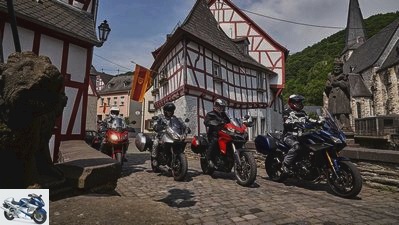
Volker Rost
16/28
With the multi-tools through Monreal.
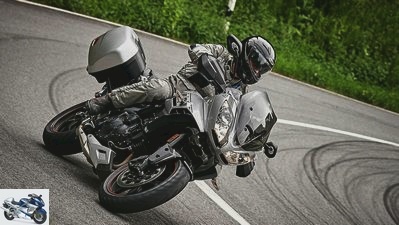
Volker Rost
17/28
Big cat with wide, concise disguise. In undulating corners, it feels like the front and rear wheels don’t quite follow the same line.
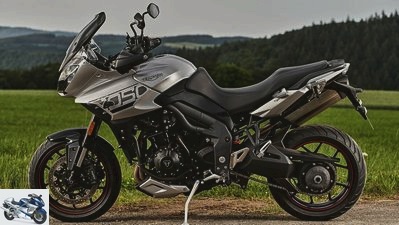
Volker Rost
18/28
The tigers are characterized by gentle, rounded shapes. Its aluminum bridge frame is characteristically formed from several profiles.
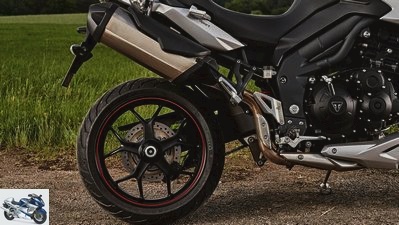
Volker Rost
19/28
Old, but fashioned: raised maxi flute from exhaust, exclusive, expensive single-sided swing arm. The fat suitcase holders look a little clumsy.
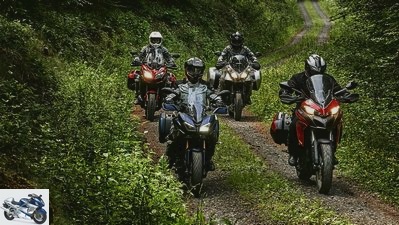
Volker Rost
20/28
Straight through. These are not real enduro bikes, but they are fully suitable for the open air. Suitable for the Eifel: It unfolds a quiet charm, every day and every hour more.
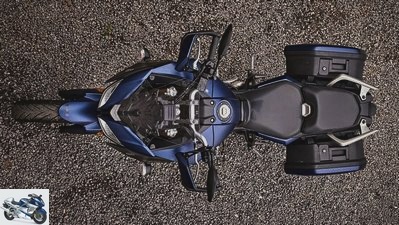
Volker Rost
21/28
New seats (height adjustable at the front) and narrow waist on the Tracer,
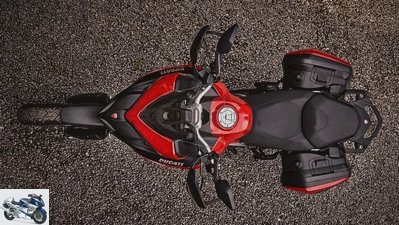
Volker Rost
22/28
plus narrower hand protectors in 2018. Bird’s beak, well-integrated case and wide handlebars on the Multi,
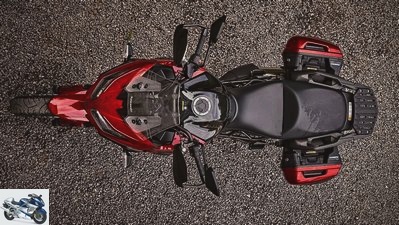
Volker Rost
23/28
Comfort armchair (also in the back) on the Versys.
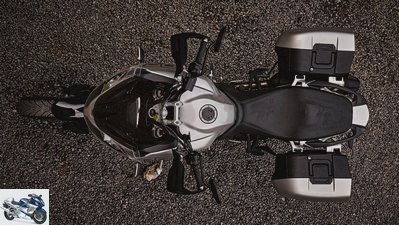
Volker Rost
24/28
The Tiger cases are particularly wide.
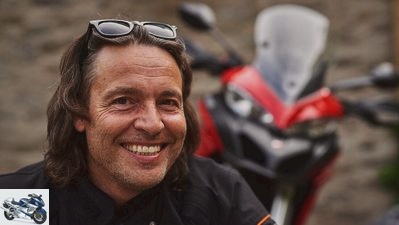
Volker Rost
25/28
Peter Klein (Motocrosser) The Ducati is clearly my favorite. She drives sporty and spirited and is still absolutely suitable for travel, offers the best wind protection. In this class it is the most complete, the best motorcycle.

Volker Rost
26/28
Ferdinand Heinrich (trainee) The nickname Tourer says it all! The Kawasaki is a good-natured, comfortable touring steamer. Despite the high-torque four-cylinder, I didn’t quite get the spark.

Volker Rost
27/28
Thomas Schmieder (test editor) The enthusiastic Yamaha has heart and soul in its tank. A three-cylinder belongs in every good garage, and this little one is a really big one. The overall package is prepared for all eventualities.

Volker Rost
28/28
Sven Loll (stunt driver) Oldie but Goldie: Old but tried and tested. The Triumph three-cylinder is still a stunner, up to date. However, one cannot deny the feeling of mass that is constantly on the move.
motorcycles
4 all-rounders with travel talents
Tracer 900 GT, Multistrada 950, Versys 1000 Tourer and Tiger Sport
4 all-rounders with travel talents
These fun bikes can also travel. The test shows which motorcycle has the most universal talents: Yamaha Tracer 900 GT, Ducati Multistrada 950, Kawasaki Versys 1000 Tourer or Triumph Tiger Sport?
Thomas Schmieder
07.09.2018
Yamaha Tracer 900 GT, Ducati Multistrada 950, Kawasaki Versys 1000 Tourer and Triumph Tiger Sport – striking fronts make it clear who is coming: the technically and visually newly renovated Yamaha Tracer 900 GT shines with a magnificent 847 cubic triple. Plus with a fireworks display for just 12,500 euros. The next largest engine has the Ducati Multistrada 950 with 937 cm3 V2, for around 13,500 euros. However, the suitcase and main stand still cost extra. They are in the four-cylinder Kawasaki Versys 1000 Tourer series. That puts almost 14,000 euros into perspective. The fully equipped Triumph Tiger Sport costs around 15,000 euros.
Buy complete article
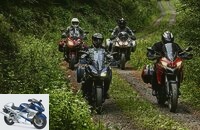
Tracer 900 GT, Multistrada 950, Versys 1000 Tourer and Tiger Sport
4 all-rounders with travel talents
16 pages) as PDF
€ 2.00
Buy now
All-rounders, adventure tourers, crossover bikes
These are three characteristic engine concepts with their own charm. An attractive basis. First finding: three-cylinder engines are now able to win a majority. In general, upright, raised seating positions behind wide handlebars give you a good feeling in the many blind corners. Easy handling as well as easy-to-swallow, long-stroke suspension elements with a high degree of lean angle top the driving pleasure. After just a few kilometers, it is clear that no matter what you call these two-wheeled talents, multi-tools, all-rounders, adventure tourers or crossover bikes (three have 17-inch front wheels) – they are simply great fun to drive. Just without big off-road ambitions.
Neither Peter on the Ducati nor Ferdinand on the Kawasaki, neither Sven on the Triumph nor I on the Yamaha have to or can each turn down one of the gears fully. It’s an open secret: You never get more than 70 or 80 hp on winding country roads. The Ducati is already there Multistrada 950 as the weakest machine of the quartet, nominally 113 HP ready, in real terms it is 109. That is the level of an air-cooled R 1200 GS. So there is no shortage of performance. Welcome to the here and now with the great touring quartet.
Yamaha Tracer 900 GT
The 115 hp propellant of the Yamaha Tracer 900 GT is a big hit. Even in the lowest speed range, the three-cylinder runs smoothly, is always wide awake and very elastic. At 5,000 tours, the colorful speed range switches from black to green. The signal: From now on there is real music in the booth! The triple fires violently from the corners. Hot, the great midrange power turns on. Wonderfully muffled, but also discreet, not at all intrusive, the three-of-a-kind hisses and roars to itself. It can be quietly driven through the villages in a resident-friendly manner.
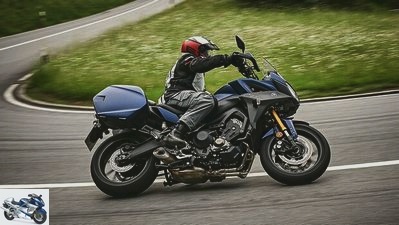
Volker Rost
Curve artist with a mere 847 cubic meters. The design? Edgy and crispy.
If necessary, this broadband motor knows turbine-like revving. The lively engine chases its crankshaft in circles up to 10,000 times per minute without beaming the twelve valves into orbit. But it doesn’t have to be. We’re on tour. High-frequency, then annoying vibrations tingle at the top. And the quickshifter does not work well in the partial load range: the throttle valves have to be wide open so that the next gear slides smoothly in. The two-stage traction control regulates either fairly early or very late.
Yamaha trimmed the 2018 Tracer 900 towards greater stability. This is now guaranteed by a six centimeter longer swing arm and a reinforced rear frame with integrated case holders. The passenger is flattered by wider handles and lower footrests on longer arms. For the driver, the height-adjustable front part of the seat bench is five millimeters thicker. In addition, a wider disc à la Multistrada with one-hand adjustment by 50 millimeters. More discreetly designed hand guards make the somewhat narrower handlebars ten centimeters less wide. That’s a good thing when meandering through traffic jams.
In addition to the mentioned goodies of the 2018 Tracer, the new GT version has exclusive equipment features for a moderate 1,600 euros surcharge: cruise control, heated grips, the TFT cockpit mentioned and the assistant for clutch-free upshifting. There is also a shock absorber with a handwheel and a golden upside-down fork with adjustable compression damping. Everything rounded off by standard 22-liter side cases with lids painted in the vehicle color. Clearly: The low-budget tourer Yamaha Tracer 900 GT is the starting point for this test.
Ducati Multistrada 950
Peter piloted the Ducati Multistrada 950. The V2 inherited from the Hypermotard is not a child of sadness, the small multi is a real jack-of-all-trades. She has a reputation to defend. Because she came, saw and conquered. In 2017, it immediately outstripped the Honda Africa Twin, KTM 1090 Adventure and Suzuki V-Strom 1000 XT in a comparison test. Made-to-measure debut. The Ducati is a real cross-border commuter: in our test field, only it has a 19-inch front wheel. They also stamp the longest suspension travel on the test field into a real road enduro, a full 170 millimeters at the front and rear. Almost enduro-like. Spoked wheels are also available for an extra charge.
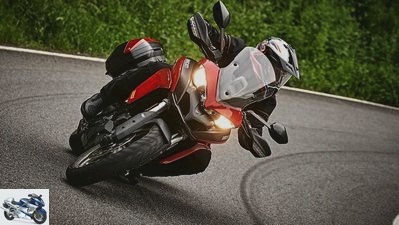
Volker Rost
Always enough power: ten years ago not even the most powerful enduro bikes had 113 hp rated power.
The short-stroke V2 with the highest compression ratio of 12.6: 1 with the fat 94 pistons sounds more like the paddock than touring. In the great outdoors, the powerful V2 staccato seems too intrusive. “It’s a Ducati, it’s allowed to do that,” Peter counters, “it’s a great sound.” He drives motocross and super athletes privately. Of course he likes the hot-spurred Multistrada, the wanderer between worlds. Peter misses a gearshift for the somewhat gnarled Ducati gearbox, “I’m just spoiled”. The Italo engine runs really smoothly from 3,000 tours and gets right down to business at 4,000. Then there is no stopping it.
The Duc rushes forward fiery. From zero to 100 in 3.4 seconds. If it had to be and Peter didn’t care about the clutch. This is exactly the value of the Triumph Tiger Sport and roughly the level of an R 1200 GS. To ask? The passage in sixth gear is more meaningful. Four seconds from 60 to 100 km / h. Here the V2 takes a breather, the three other machines make it a few tenths of a second faster. But from 100 to 140 and from 140 to 180 the Ducati pushes the fastest in the last gear.
Kawasaki Versys 1000 Tourer
Ferdinand is an intern. And drives the Kawasaki today. How does he like it Kawasaki Versys 1000 Tourer? “It’s a gentle giant, good-natured, but not sedate.” A highly flexible engine for balanced characters. It purrs casually with just above idle speed. Tempo 50 in sixth gear, with almost 2,000 revolutions? Pure pleasure.
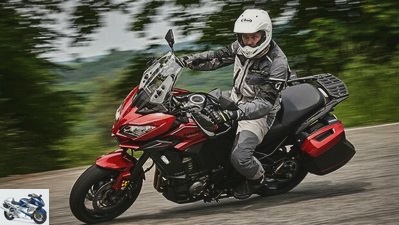
Volker Rost
Kawasaki’s Versys 1000 always has particularly plush seats and a lush bridge for luggage. The “Tourer” version also comes with standard cases and hand protectors.
This extremely supple four-cylinder with the muffled whispering sound once came from the bare Z 1000 and was trimmed for a fat torque curve. It always offers power. Creamy and creamy like the ice cream that is waiting for us in Cochem. Even at low speeds, there is a lot of progress. The fact that the Kawa hangs a little sluggishly on the gas and subjectively revs up a little more slowly than the other three in the second half of the engine speed is a given. Better mild than wild. No mistaking that Kawasaki Versys 1000 Tourers can be angry too. But do not incite them to do so. The slipper clutch with servo function works extremely smoothly, just like with Tiger and Yamaha. Two fingers are enough. Very pleasant.
Triumph Tiger Sport
Right from the start, the Triumph Triple sounds grumpy-throaty, bassier than the Yamaha triplet. The long-stroke 1050 hangs softly and with little load change on the gas, converting every slightest turn of the electronic gas handle into propulsion. An engine like velvet and silk. And almost a classic: The first Tiger 1050 appeared in 2006. With the Euro 4 update in 2016, the claws of the big cat were sharpened, the cylinder head, piston and throttle body modified as well as the balance shaft and exhaust manifold. There were also three driving modes, better ABS and traction control.
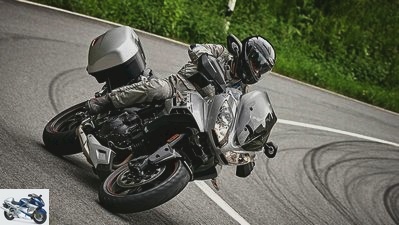
Volker Rost
Big cat with wide, concise disguise. In undulating corners, it feels like the front and rear wheels don’t quite follow the same line.
You shouldn’t blindly rely on the latter, the rear wheel can spin on a wet meadow. Or is it the heavy punch? The triple of the Triumph Tiger Sport draws its power powerfully and evenly across the entire rev range and hangs smoothly on the gas. Typically three-cylinder, not as smooth as a four-cylinder, not as rough as a V2. Okay, the 1050 acknowledges engaging first gear with a wooden gear stick. But then the gears slide smoothly and smoothly through the gearbox. The overall gear ratio correlates with the displacement: the Tiger 3,900 rpm in the sixth, the Versys 4,050 rpm, the Tracer 4,450 rpm and the particularly high-speed Multistrada 4,550 rpm for real 100 km / h.
ergonomics
“What a fat chunk”, it shoots through my head when I switch to the Triumph Tiger Sport for the first time. It feels like the instruments are a meter away from the sight. It sits strangely on the Tiger: The wide tank spreads the legs wide apart, the pegs are sloping-friendly high. As a result, the knee angle is acute. Traditional tourer or simply old fashioned? In addition, there is the high focus. In contrast, the Yamaha Tracer 900 GT looks much more compact, delicate and lighter: a delicate 217 kilograms without a case. That is really little! Riders of all stature sit well in the Yamaha saddle with the narrow waist. If you sit upright, you are even more forward-looking.
Despite the tracer’s new bench foam, the bottom is grateful for a break after a few hours. Long guys sometimes hit the lower seated passenger pegs with their boot legs. The handlebars are well at hand. With your eyes blindfolded you would recognize the typical feeling of sitting on the Ducati Multistrada 950, which weighs 241 kilograms. Subjectively, you sit deep in the motorcycle, the wide, high handlebars as well as the windshield close to your chest. “Perfectly integrated,” says Peter happily. “A little submissive, firmly nailed down,” says Sven. Annoying when turning: the brake pedal is too far in, can hardly be reached.
The wide handlebars and the plush seats characterize Kawasaki’s feel-good motorcycle. The super comfortable adventure tourer weighs a full 252 kilograms plus the case. Seating comfort is greatest both in front and behind. The Versys 1000 acts as a rolling relaxation program, is balanced and easy to handle. Even jacking up on the standard main stand is easy – as with Ducati and Yamaha. The 244 kilogram Triumph has none.
Serpentine test drive
We have now reached the roller coaster between Monreal, the pearl of the Eifel, and Kaisersesch. Bend follows bend, curve after curve. Splendid. In the serpentines, the quartet is divided into two groups: the duo of Ducati and Yamaha sprinting ahead with research emotions. Kawasaki and Triumph take it a little more relaxed. Multistrada and Tracer were born with the sheer pleasure of waving. Rock ‘n’ Roll! Both “900s” drive enthusiastically and sensually. This combination of sport and touring, the overall package, is fascinating. Versatile and fiery. The Tracer drives agile, but never nervous, handy and very reliable and neutral. The GT follows the line as precisely as a laser beam, the longer swing arm certainly didn’t do any harm.
The wheelbase of the Yamaha Tracer 900 GT is still the shortest of the quartet. The fork is steep (66 degrees steering head angle), the caster is moderate (100 millimeters). The fully adjustable fork could use a bit more compression damping, we turned it down to two of 13 clicks, while the rebound damping was turned up halfway. The spring strut, which tends to be stiff, covers a wide area and at most lets through short, hard shocks from time to time. The Multistrada makes it a bit better than the Tracer. It even remains more stable on course. Your secret? Part of the combination of a single 19-inch front wheel and a narrow 170-inch rear tire is certainly part of it. With the other three, a wider 180 rotates.
The Ducati Multistrada 950 successfully compensates for the most stretched wheelbase and, together with the Kawasaki, for the longest caster. In addition, their long-stroke spring elements iron everything smoothly in an enduro-like manner. The 950er benefits from great Pirelli tires, Scorpion Trail II in special code D. They stick great, while the Dunlop D 222 L from Yamaha roll a bit wooden. Good rubbers have also raised Kawasaki and Triumph, Bridgestone T 30 F and Pirelli Angel ST. The Versys 1000 is nice and full, but stiffens a little when turning quickly in alternating curves. She is the least curvy. The slimmest fork hits the heaviest weight.
2018 no update for Tiger Sport
After all, as with the Multistrada, the suspension comfort is high. Raising the spring base, as with Ducati and Yamaha with a practical handwheel, brings a few degrees more freedom of inclination before the fear nipples scratch the curve. With the Tiger, the steepest fork (67.2 degrees) meets the shortest trail (89 mm). But maybe that’s too much of a good thing. Because the Triumph mills a little inhomogeneously through the curves. It feels as if the front and rear wheels are not exactly following the same line, as if there is a ball joint in the middle of the motorcycle. This effect is even more pronounced on bad roads. Then the motorcycle feels bigger than it is.
So the Triumph Tiger Sport doesn’t quite live up to its nickname. Well, unlike the Triumph sisters with 800 and 1200 cubic meters, the Tiger Sport has to do without an update for 2018. You can tell.
Case, payload, connectivity
All (painted) cases are easy to use. The Triumph on the left is particularly voluminous, but its rear end is also a little too wide. The luggage boxes from Ducati and Kawasaki are easy to use and cleverly designed. The shapely, hexagonal Yamaha cases swallow a helmet neither on the right nor on the left.
A tourist disadvantage of the Tracer GT is that it has too little payload for two-person operation: it saddles 177 kilograms, with suitcases even only 166. At the other end of the spectrum, the Ducati tows a lush 224 kilograms (minus the suitcase). The Yamaha can shine with easy headlight adjustment without tools and an on-board socket in the cockpit. The Ducati carries that under the seat, as well as a USB port. Useful for sat nav and smartphone. It’s a shame that tracers like Multistrada don’t allow you to adjust the clutch lever. Kawasaki and Triumph can do that.
Braking, straight-ahead wind protection
What about the braking chapter? No pleasure for Ferdinand on the Kawasaki. Your stoppers look strangely mushy, he can pull the hand lever up to the throttle grip. Good feeling is different. On the Yamaha I am irritated by the clumsy ABS control behavior with hard, long interventions. One can expect more from the second largest motorcycle manufacturer in the world. If I step on the brake pedal on the Tracer with the emergency braking downhill, the rear wheel wedges sideways, I have to loosen it. Is that the point? The particularly crisp feeling on the hand lever for the four-piston stoppers fades a little.
Our test is coming to an end. Time to test the parade disciplines of touring motorcycles: wind protection and straight-line stability. Despite the very long swing arm, the tracer moves beyond the speedometer display 200. That’s it’s. Well, it is limited to a speed of 210 (speedometer over 225!). The windshield is not quite optimal despite the improved, somewhat stiff, sliding pane. Chest and neck take off – pleasant at 30 degrees Celsius, but probably too much in the cold.
The Ducati Multistrada 950 offers the best wind protection and the lowest volume level of the entire quartet. Really good. In addition, there is excellent straight-line stability – even with loaded suitcases, the Duc remains bolt-stable. Class. And what about the Kawasaki as a tourer par excellence? She also commutes beyond 200 with her suitcases. Worse still: Long guys plague from a speed of 140, 150 violent turbulence on the helmet. Even with the pane up (mechanism is in front, so you have to get off) Ferdinand does not feel completely comfortable. He has to make himself small. That leaves the triumph. There is no turbulence here when the windshield is set low, but there is significant wind pressure on the torso and shoulders. Sven freezes without a scarf. The tigers also move minimally.
Ultimately, the Triumph ends up ungrateful behind. And the second triple? It wasn’t quite enough for the Yamaha Tracer 900 GT to win the test. In view of the low price, however, it is definitely a moral winner. The Kawasaki Versys 1000 Tourer is a bit of a gray mouse even in red and is easily underestimated. On the other hand, the fiery red Multistrada (it is also available in snow white) can no longer take the butter off the bread. A great Italo tourer.
Related articles
-
jkuenstle.de 65 pictures jkuenstle.de 1/65 All candidates in the crossover comparison test are around 1000 cm³, this time they are represented ……
-
Tested off-road tires for large travel enduros
17th pictures Markus Jahn 1/17 The Bridgestone Battlax AX 41 is the tip for off-road-oriented travel endurists. 2/17 Even after more than three decades,…
-
Product test: long-distance travel textile suits
Herder clothing Station wagons, jackets & pants Product test: long-distance travel textile suits Product test: long-distance travel textile suits…
-
Tips for motorcycle travelers to prepare for long-distance travel
Photo: Biebricher 27 pictures Army car 1/27 A MOTORRAD volunteer fulfills a lifelong dream: from Alaska to California on a motorcycle. Army car 2/27 Pure…
-
Road tires 2019 for large travel enduros in the test
Markus Jahn 17th pictures Markus Jahn 1/17 Which tire pairing has the edge after the tour over streets of all stripes?? Markus Jahn 2/17 If you value…
-
to travel Travel with athletes Travel with athletes Polar round Oslo, Trondheim, Mo I Rana, Helsinki ?? 6000 kilometers in 10 days through the wild north…
-
The all-rounders of the Alpine Masters 2012 in comparison
Gargolov 16 pictures Gargolov 1/16 Honda NC 700 S: As soon as the 700 does not feel overwhelmed, as soon as it is allowed to set its own pace, everything…
-
Daytona Travel Star GTX motorcycle boots in the endurance test
Roman Kirschbauer clothing Boots Daytona Travel Star GTX motorcycle boots in the endurance test Daytona Travel Star GTX Motorcycle boots in the endurance…
-
Voge 650 DSX: New mid-range travel enduro
News 2022 New motorcycle items for 2022 Voge 8th pictures Voge 1/8 The Chinese provider Voge is expanding its portfolio to include the 650 DSX travel…
-
to travel Travel report Isle of Man Travel report Isle of Man Isle of Man: The motorcycle island It is impossible to report about the Tourist Trophy…